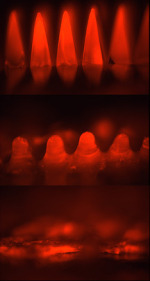No More Fear of Needles For Vaccinations? Yes Please!!
A square of 100 dissolving microneedles is shown here on a U.S penny for size comparison.
Introduction
Would you ever believe me if I told you there was a painless way to get vaccines without proof? I wouldn't have. But it's true! Mark Prausnitz teamed up with Mark Allen to create a painless patch of microneedles that deliver vaccines just as effectively as traditional hypodermic needles.
Discovery
The study conducted at the Georgia Institute of Technology involved Jeong-Woo Lee, Vladimir Zarnitsyn, Seong-O Choi, Niren Murthy and Mark Allen besides the main researcher, Mark Prausnitz. They have done many experiments with many edited hypotheses. They have experimented on mice and hope to be able to test hypotheses on humans in the near future. It is anticipated to be FDA approved in the next 5-10 years. These studies are believed to be the first of their kind. Research was supported by the National Institutes of Health.
The microneedles are just 650 microns long and are made into a 100 microneedle square for the mouse studies. They are shorter than the thickness of a nickel on its back. The microneedles only pierce the outer layers of skin.
In the main study there were three groups of mice. One group of mice were given the flu vaccine using hypodermic needles to inject the vaccine into the muscle; the second group of mice was given the flu vaccine using the experimental version of the dissolving microneedle squares. A control group of mice had vaccine-less patches applied to their skin. Infected with influenza 30 days later, mice in the control group died while both groups who had recieved a form of vaccination remained healthy as a horse.
It was determined that animals vaccinated with microneedles appeared to have a better "recall" response to the influenza virus and therfore were able to rid their lungs of the virus more effectively than animals injected by traditional hypodermic needles.
Microneedle bandaid-like patches are pressed into the skin. The microneedles dissolve quickly in bodily fluids, leaving only the water soluble backing of the patch. The backing can easily and safely be discarded because there are no dangerous sharps left. The dissolving process can take anywhere from a minute to fifteen minutes.
This new patch method could actually be more effective than the traditional vaccination using hypodermic needles because standard vaccines are injected into muscles rather than straight into the top layers of the skin. Why does this matter? There really are no immune cells in the muscle. With standard injections, the vaccine has to find its way from the muscle to the blood and lymph system to come across the cells that spur protection. However, the microneedle patch delivers the vaccine right into the immune-cell-rich skin. Many studies have shown that skin-based delivery of vaccines is more effective than injections into muscle. This stronger response may make it possible to obtain equal or superior protection with lower doses of vaccine.
The microneedle squares or "arrays" are made from a polymer material, poly-vinyl pyrrolidone that has been shown to be safer to use in the body. Freeze dried vaccine is mixed with the vinyl-pyrrolidone monomer before being put into microneedle molds and polymerized at room temperature using ultraviolet light.
Although there have only been studies of administering the influenza vaccine so far, the technique should be appropriate for other immunizations. However, before this method of vaccination can be made widely available, more clinical studies will have to be done to assure safety and effectiveness.
Biography of Mark Prausnitz
Mark Prausnitz is Associate Professor of Chemical and Biomedical Engineering at the Georgia Institute of Technology. He has a BS (1988) from Stanford University and a PhD (1994) from Massachusetts Institute of Technology. Dr. Prausnitz' research interests concern novel uses of ultrasound, electric fields, and microfabricated devices to enhance and target drug delivery. Dr. Prausnitz has recieved the CAREER Young Investigator Award from the National Science Foundation, TR100 Young Innovator from Technology Review, Junior Faculty Research Award from Sigma Xi, Outstanding Pharmaceutical Paper and Outstanding Transdermal Drug Delivery Awards from the Controlled Release Society, and Best Paper Award from the Journal of Clinical Engineering. He has published almost 50 research articles, holds almost 20 issued or pending patents, consults for a number of companies, and has served as an expert witness.
Future Impact on the World/Humanity
These nifty patches of pain-free health will have a huge impact on the world if they are approved for use on humans. They could also have a big impact on the animal world.
Because the microneedles dissolve, there would be no need for special disposal of the needles. This would mean less sharp disposal to pay for, and less space needed to store the used needles before complete disposal.
Since the procedure is so simple, people would have faster and easier access to vaccines and assorted medicines. There would be no need for experienced medical staff to administer it, so you could eliminate that payment in total.
Because of the dry formula, it would be cheaper and easier to store them. they could hypothetically be good for months. this would allow massively easier access in poor countries.
In many parts of the world, bad medical infrastructure leads to reusing needles, which contributes to the spread of diseases like HIV and hepatitis B. Dissolving microneedle patches would eliminate re-use while allowing vaccination to be done by personnel with minimal training or just by themselves.
This new vaccination technology could simplify vaccination programs in assisted living homes and schools.
Because of the moronically simple procedure, it could prevent accidents and re-sticking with hypodermic needles. With this band aid like patch, immunization could be available over the counter. Microneedle patches could also potentially be used for insulin, which would help millions of diabetics all over the world.
In many parts of the world, bad medical infrastructure leads to reusing needles, which contributes to the spread of diseases like HIV and hepatitis B. Dissolving microneedle patches would eliminate re-use while allowing vaccination to be done by personnel with minimal training or just by themselves.
This new vaccination technology could simplify vaccination programs in assisted living homes and schools.
Because of the moronically simple procedure, it could prevent accidents and re-sticking with hypodermic needles. With this band aid like patch, immunization could be available over the counter. Microneedle patches could also potentially be used for insulin, which would help millions of diabetics all over the world.
Journal Article Review
This journal article was about the passage for immunizations into targeted locations in the body. "The biological barriers that block transport are usually int he form of lipid bilayers, either cell membranes or the lipids found in skin that prevent drugs from entering the body. By selectively and reversibly disrupting those biological barriers, drugs can be delivered into the body across the skin and into targeted cells through short lived hole in their membranes."
Sources!
Prausnitz, M. (n.d.). Abstract. Retrieved from http://www.chem.ucsb.edu/~bioengr/mark%20Prausnitz%20abstract.htm
Sanders, L. (2010, July 19). 'ouchless' microneedles delivre pain-free vaccines. Retrieved from http://news.discovery.com/tech/ouchless-needles-flu-vaccine.html
Toon, J. (2010, July 18). Disappearing needles. Retrieved from http://gtresearchnews.gatech.edu/dissolving-microneedles-patch/
Sanders, L. (2010, July 19). 'ouchless' microneedles delivre pain-free vaccines. Retrieved from http://news.discovery.com/tech/ouchless-needles-flu-vaccine.html
Toon, J. (2010, July 18). Disappearing needles. Retrieved from http://gtresearchnews.gatech.edu/dissolving-microneedles-patch/
Pink dye shows how vaccines would be in the microneedles.
The microneedles dissolve after fifteen minutes.
Microneedle patches are smaller than a nickel!





No comments:
Post a Comment